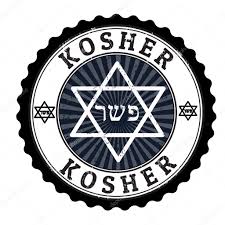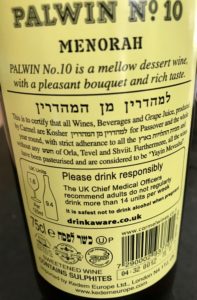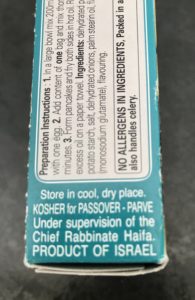In this article I will explain the Jewish Food Laws -what ‘Kashrut ‘ and ‘Kosher’ mean and how these laws apply in Jewish everyday life.
(See also Subdivisions within Judaism )
The general principle behind Kashrut is that Jews must be clean in body and soul.
What?
Kashrut ( Hebrew – fit, proper ) is a set of dietary laws which deal with the food Jews are permitted to eat and how those foods must be prepared according to Halacha (Jewish Law).
Kosher (same meaning as above) is the adjective applied to foods that may be eaten according to the above Law.
(The word is now used more broadly in society to apply to anything that is ‘legitimate’ or ‘above board’.)
Origins
Some people consider that the historical origin of the Kashrut, the Kosher food laws, is somewhat obscure and so is the rationale behind it. It is generally considered to be for reasons of hygiene, self-discipline and religious separation ie: a statement of Jewish identity.
There are Biblical references to food as early as the first chapter of Genesis where God states that trees will provide seeds for man to eat.
In Leviticus there are prohibitions against consuming blood and references to forbidden food throughout the Torah. In Leviticus and Deuteronomy there are lists of permitted animals.
In post Biblical times, the laws expanded and practices became quite specific in nature as interpreted by the Rabbinical authorities.
These were eventually written down in the Mishnah and the Talmud in order to safeguard the Biblical laws.
An historical dimension to Kashrut is that it has been used throughout history as an instrument of Jewish persecution. From the Hasmonean era (see Chanucah), to the Nazis, Jews have been forced to eat forbidden foods as a way of violating and destroying their Judaism.
Basics of Kashrut
1) Certain species of animals and their eggs and milk are permitted whilst others are forbidden, notably pork and shellfish.
Mammals are Kosher if they have split hooves AND eat grass. Examples are cows, sheep, goats and deer. Non Kosher examples are pigs, (including foods containing its fat or collagen eg: gelatine), horses, squirrels, bears, dogs, cats and camels.
Fish are Kosher if they have fins and scales. Examples are salmon, tuna, flounder, herring, pike and carp. Non Kosher examples are all shellfish both crustacean and mollusc- they are known as ‘bottom feeders’ for obvious reasons! Others not permitted are water mammals, sharks, swordfish and sturgeon.
Fowl – most domestic birds are Kosher such as chickens, ducks, geese, turkeys and pigeons.
Non Kosher examples are mostly predatory and scavenger birds, for example, vultures, ostriches, hawks and seagulls.
Reptiles, amphibians, worms and insects (anything that ‘creeps’ or ‘crawls’) are Non Kosher with the exception of four types of locust.
2) It is strictly forbidden to eat flesh removed from a living animal.
Meat must come from Kosher animals that are slaughtered in a specific, humane procedure called Shechitah, by a specially trained, observant Jew – the Shochet.
The internal organs, particularly the lungs, are examined for imperfections which will render the animal Non Kosher.
Certain forbidden veins and fat will be removed from cattle. These are particularly prevalent in the hindquarters and because of the complexity of their removal, this body part is not generally sold as Kosher.
The blood of all mammals and fowl must not be consumed as it represents the life and soul of the living being. Within 72 hours of slaughter all extractable blood is removed by a special soaking and salting process. The liver has a very high blood content and so has to undergo a special boiling process.
3) Fruits, vegetables and grains are always Kosher but must be washed very thoroughly and be free of insects. Wine and grape juice however must be certified as Kosher (see below no.4) and only handled by Jews. (This rule dates back to when non Jews worshipped idols and used wine for pagan worship). Eggs must be carefully examined to ensure they don’t have blood spots – this makes them Non Kosher.
4) Since even a trace of Non Kosher substances can render food Non Kosher, all processed foods and eating establishments require certification by a reliable Rabbi or a Kashrut Supervision Agency. See below for some examples of labelling.
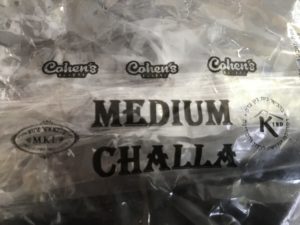
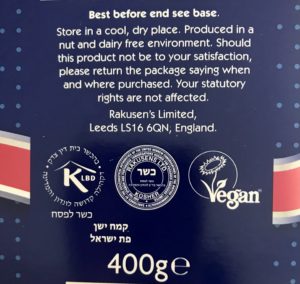

The word Treif also known as Terefah ( Hebrew- torn, defect ) refers specifically to Non Kosher meat but more generally as any Non Kosher food.
The Separation of Meat and Dairy Foods
What?
This is a separate practice from eating Kosher foods. It is followed by Orthodox Jews but not so stringently by Progressives.
Why?
The origin comes from the Torah where it states ‘one must not boil a kid (ie: baby goat) in its mother’s milk’. This was later interpreted by the Rabbis as meaning that the two food items must be kept separate. One explanation for this verse is that it referred to a pagan fertility rite where the ‘mixed milk’ known as ‘magic broth’, was sprinkled over the land and that God was in fact, prohibiting this heathen practice.
How?
Kosher foods are divided into three categories:
Meat and fowl including the bones and subsequent soups and any food containing even a small quantity of such.
Dairy, including milk from Kosher animals, all milk products eg: cream, butter, cheese and yogurt and any food containing even a small quantity of such.
Pareve (also known as Parve) foods are neutral ie: neither meat nor dairy. These include all Kosher fruits, vegetables, (ie: insect-free), eggs and egg products such as mayonnaise, honey and grains. These can be eaten with both meat and dairy. Interestingly Kosher fish are Pareve but not eaten with meat eg: ‘Surf and Turf’, due to health reasons outlined in the Talmud.
In Practice
Jews following this will not eat meat and dairy in the same meal (eg: no lasagne, cheeseburgers etc, not even milk in a cup of tea accompanying a beef sandwich! )
There are different practices regarding the length of time between eating the two.
For example, some Jews will not even eat the two items on the same day, some will leave six hours after eating meat before eating dairy and between half an hour and three hours vice versa. The rationale for this is that meat is thought to leave a fatty residue and an aftertaste in the mouth whereas dairy is thought to travel quicker through the body.
The Kosher Kitchen
In ‘Kosher keeping’ Jewish homes and restaurants, there will be two separate areas of the kitchen to deal with meat and dairy.
This includes designated cookers, sinks, fridges, freezers, microwave ovens, pots and pans, crockery and cutlery etc.
Items must never be swapped and are often labelled accordingly to prevent confusion.
In restaurant settings, all Kosher practices are continually monitored by Rabbinical supervision. In most cases they serve either meat or dairy. In hotels in Israeli there are usually two restaurants, one for each type of food. One can also find Vegetarian/ Pareve Kosher restaurants. All Kosher restaurants are closed on Shabbat and Jewish festivals.
Synagogue Practice
Orthodox Synagogues will keep Kosher kitchens (see above). Progressive Synagogues will use Kosher meat although many prefer to just offer fish and/or vegetables to be on the safe side. This avoids offending any strictly observant members and prevents Kashrut from separating one Jew from another.
Wine used for Kiddish in Synagogue must be Kosher for the same reason.
Advantages of Keeping Kosher
- It ensures that food is very thoroughly prepared and cooked in the most hygienic way possible.
- No potentially harmful food is allowed and food is well cooked to eliminate all traces of blood.This means that food reaches a high enough temperature to kill off harmful bacteria.
- Shechitah is designed to limit animal suffering to a minimum and therefore is the most humane way of slaughtering animals for food.
- It encourages self-discipline, humility and compassion.
- Keeping Kashrut ensures that your home is a place where other strictly observant Jews can eat.
- The reduction in social mingling with either non Jews or less observant Jews lessens the possibility of inter-marriage and its potential problems.
- It connects Jews with their past, present and future and brings the worship of God into every day life.
Disadvantages of Keeping Kosher
- In order to keep Kashrut fully, the reality is that Jews have to live in an area populated by other Jews where one has access to Kosher butchers, bakers, grocers etc. There is difficulty of supply in non-Jewish areas but some Synagogues buy in frozen Kosher food to help with this.
- Kosher food is always more expensive because of the degree of preparation involved.
- It is expensive to set up a Jewish Kosher kitchen with its two distinct sections for meat and dairy. (At Passover two entirely different sets of crockery, cutlery etc are also required).
- It can be very time consuming to prepare Kosher food.
- Jews have to be very knowledgeable about less obvious areas of the law eg: whether a food contains pork gelatine or has been cooked in lard (pork fat). Therefore one’s diet is limited to what is unquestionably Kosher.
- This also applies to eating out where Jews are limited to only frequenting Kosher establishments.
- There is a risk of offending non Jews and less strict Jews by not socialising with them or visiting their houses.
- Too much emphasis can be placed on the observance of Kashrut as opposed to moral observance ie: where gastronomy is more important than morality and where the quality of one’s Judaism is judged by what one eats rather than how one behaves.
Summary
Throughout the 4000 years of our history, the Mitzvah of following Kashrut has been a hallmark of Jewish identity. It is a continuation of our faith which binds us to our ancestors and our contemporaries and has a unifying effect, particularly when Jews are dispersed around the world.
It is a reminder, at every meal, of our faith and its constant demand to follow in the service and worship of God.
Kashrut emphasises that Judaism isn’t just a religion of spiritual holiness confined to worship in holy places but is part of everyday life. Life itself becomes an act of holiness. Even the seemingly mundane activity of eating is more than just a bodily requirement and a pleasure. It is also an ethical discipline of limiting one’s appetite in a world where many go hungry and where some forbidden foods are obtained at the cost of intense suffering by the animal.
Indeed many Jews regard the taking of an animal’s life as abhorrent and inhumane so vegetarianism is widely practiced.
In Biblical times, the food laws also served to protect the Israelites from illness caused by ‘unclean animals’. One only has to think of the lack of refrigeration and knowledge at the time to imagine what harm unchilled or undercooked pork or shellfish might do!
Of course, this is not usually a factor today but many Jews still regard following Kashrut as a healthier way to live.
Kashrut distinguishes Jews from other faiths which, in practice, serves to keep us separate from non-Jews eg: not eating in each others’ homes and not generally socialising together. This can have negative connotations but it is extremely important to understand the ethos behind it so mutual understanding and respect can be shown.
On a positive front, it serves as a means of self-protection and maintaining Jewish cohesion.
In my article on ‘Subdivisions within Judaism’ it can be seen that there is flexibility in the interpretation of Kashrut. Even those who question the idea of the divine origin of the dietary laws may observe them because they are part of the Jewish tradition and also because they add meaning to their lives.
In the main it is the post Biblical interpretation of the non-mixing of meat and dairy and the separate kitchen practice that Progressive Jews may find difficult. Therefore they may not eat forbidden food but they will mix meat and dairy. (This is what I do).
Even though there is a big grey area of observance by different Jews, the most important emphasis is on integrity and consistency. For example, to have one set of rules for eating at home and another for eating out, is not only confusing but in my view, hypocritical.
To sum up, Kashrut is a religious act of ‘spiritual nutrition’ which adds meaning to our lives and is a uniquely Jewish experience.
